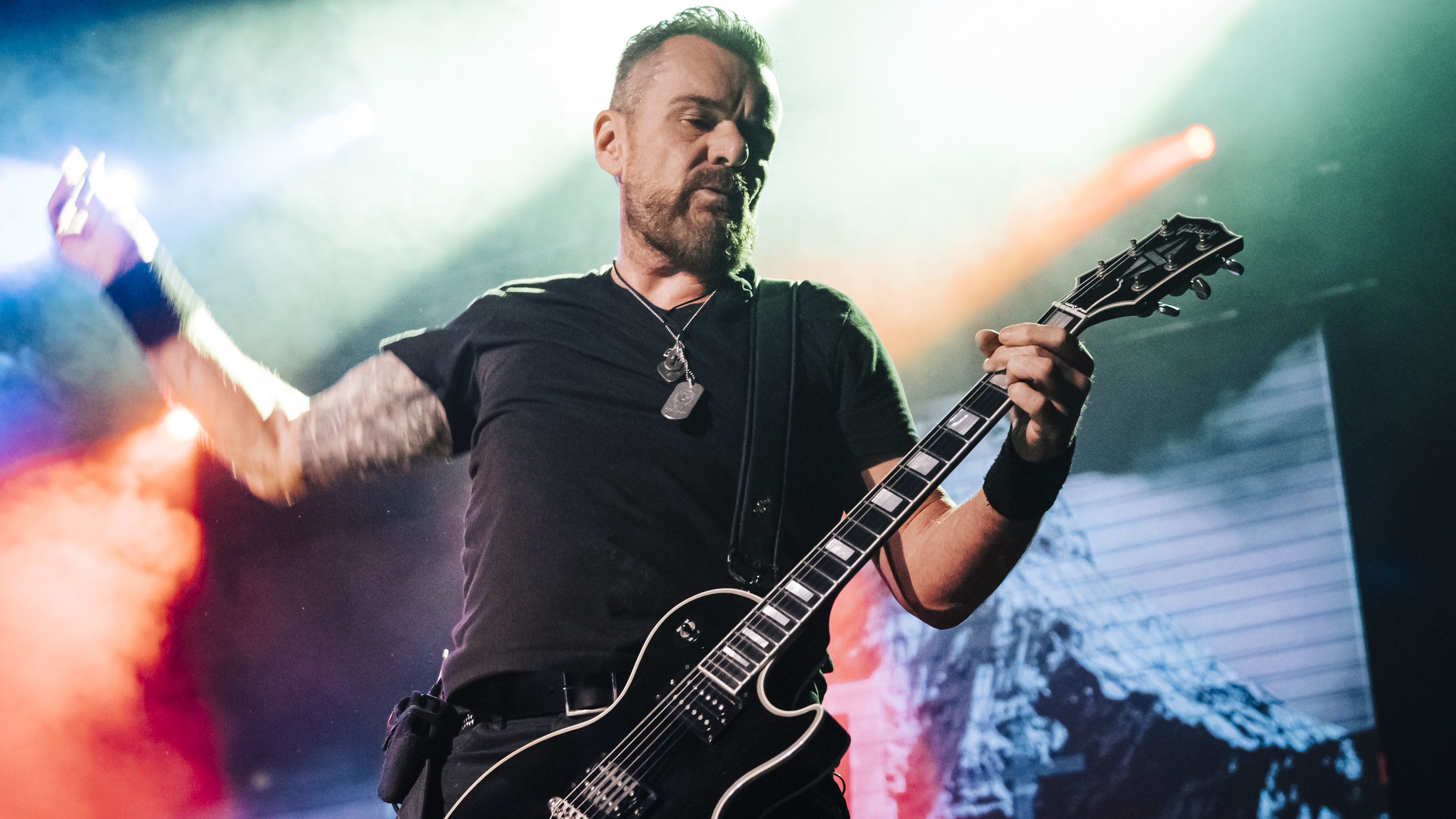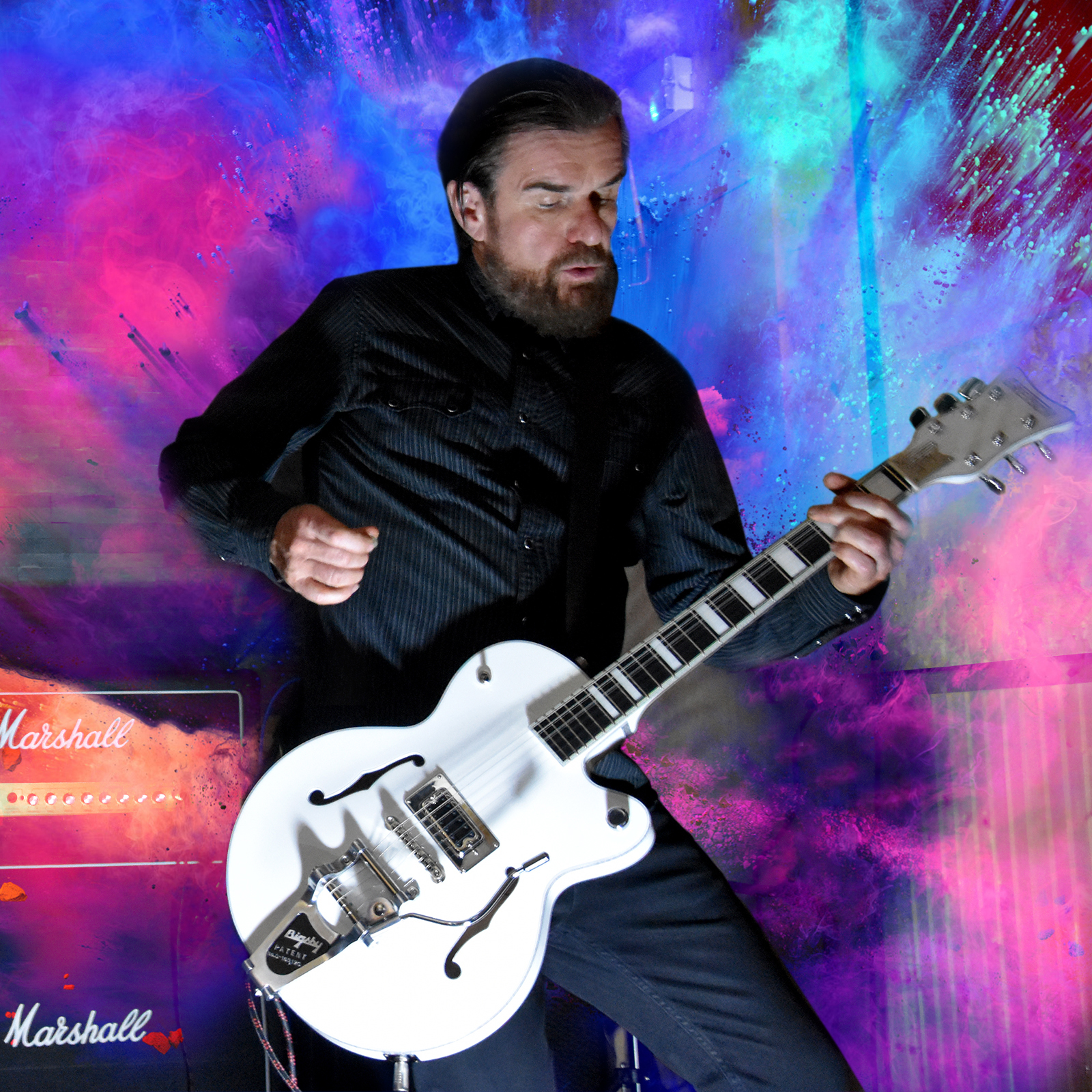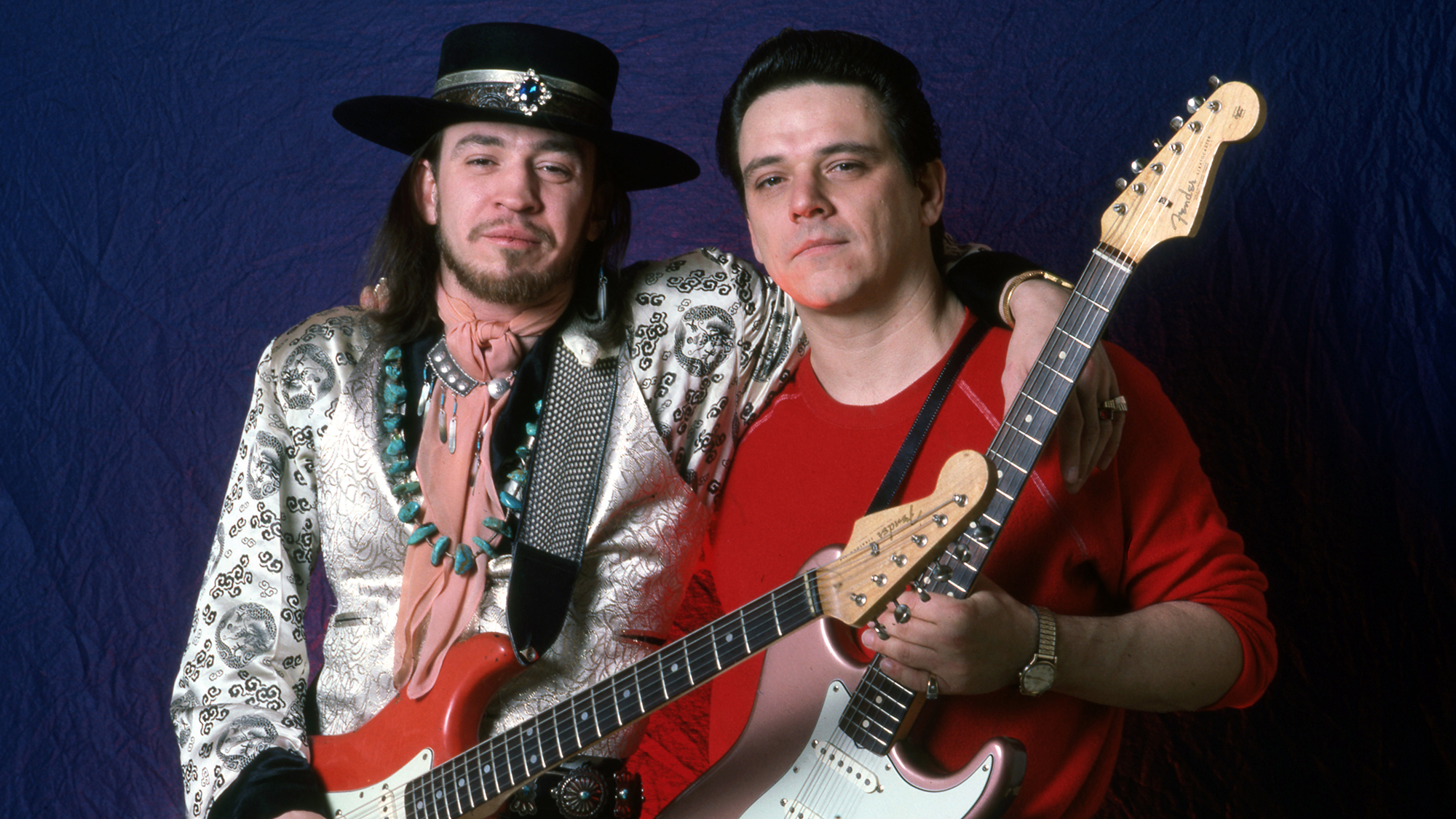Billy Duffy on Coloursøund's "unfinished business" and masterminding an all-new Gretsch guitar, the Falcon Junior
The Cult guitarist has teamed up with The Alarm’s Mike Peters for their first album in more than two decades, Coloursøund II

“We both felt that Coloursøund was a bit like unfinished business,” Billy Duffy says about his collaborative project with The Alarm singer Mike Peters. And indeed, it’s been unfinished since Duffy, then on a break from The Cult, and Peters, who likewise was on hiatus from the Welsh band he had fronted since the early ‘80s, released their debut together, Coloursøund, all the way back in 1999.
Since then, Duffy has remained plenty busy with a reunited Cult, while Peters has worked with a new version of The Alarm (dubbed The Alarm MM++) as well as launched a solo career. But the two artists’ personal and professional relationship remained strong, and so when it came to Coloursøund, it was less a question of “if” and more a question of “when.”
“Coloursøund didn’t split up in so much as I had to leave it in ‘99 because The Cult reformed and we got offered a really big record deal,” Duffy says.
“But Mike and I have always worked together over the years and we have a great connection. So when The Cult were going through a bit of a quiet period, I just felt like, you know, I like to work. And that's what Mike and I started doing.”
The result is the aptly named Coloursøund II, which picks up, more than two decades later, more or less where the first one left off, with a collection of high-energy, hip-shaking jams (see the first single, Paradise [Free People]) that, while heavily rooted in classic rock, bring in elements of the styles both artists cut their teeth on, from punk and post-punk to new wave and alternative.
If anything, the record is a bit rougher and rawer than its predecessor, and in some cases, such as the chugging, metallic Lightning Strike, even heavier.
“For me and Mike, our intention going in was just to keep a bit of the humanity and the spontaneity,” Duffy says. “Just make a rock record. We didn’t want to drag it out.”
Get The Pick Newsletter
All the latest guitar news, interviews, lessons, reviews, deals and more, direct to your inbox!
Duffy sat down with Guitar World to discuss that new rock record, as well as the connection between he and Peters that makes Coloursøund click. He also reminisced on his teenage punk years in England, including the seismic moment of witnessing the Sex Pistols and the Buzzcocks onstage in a tiny Manchester club, and then looked forward to give us some exclusive info on his recently teased collaboration with Gretsch on a forthcoming signature model. “It exists, and it sounds great,” he says.
It’s been more than 20 years since the first Coloursøund album. Why now?
“That’s a very good and reasonable question to ask. I don't know, there just never seemed to be the right set of circumstances in the last 20 years. I got busy with the Cult, and then the Cult wasn’t busy, but then Mike got busy with the Alarm and his own solo thing. I mean, Mike is probably the busiest man in rock that I know. He's always doing something.
“But in late 2019, I think, I just sent him a riff. Because what happened was, I'm still working on the new Cult album as well, and there’s a few little riffs and things that are just not seemingly right for where the Cult's at these days. So I sent one off to Mike to see how he would react.
“Within 20 minutes he'd written a verse and sent it back to me and we thought, 'Oh, okay. Maybe there's something still here…' And once we’d done that first track, which wound up being Paradise, that sort of set the intention: “Well, maybe we'll get together and write some more stuff…”
What was the process for putting this one together?
“In January 2020, we decided to get together in a little cottage on the coast in North Wales. And so that's what we did. You know, I always joke about the Led Zeppelin thing, where Jimmy Page and Robert Plant got together in a cottage in Wales and wrote songs about California. Well, we did the cottage bit, and it was great. I really loved it. As a rock fan and a bit of a rock music geek, I’ve always felt that's how records should be made, right? You go away and you get in the bubble and you make a whole magical thing.
“So that was it – we gave ourselves three days, we came up with seven or eight songs. I went back to America for a while and Mike worked on those songs, got some lyrics together. I came back to England in March, and then the lockdown happened. And basically we just sort of long-distance worked on the songs until we felt we were ready to record. And the minute they lifted the lockdown in the UK we went into the studio and cut some stuff and finished it off. And that was the album, basically. It was spontaneous. It wasn't a dragged-out thing.”

I’ve heard you talk about wanting to do something that was simple and direct, almost live-sounding, with this album. Basically, what we think of as the sound of a rock ‘n’ roll band. Which, in 2021, is sort of outside the norm.
“Yeah, I agree. Most people now are embracing technology and making records in a different way and, you know, there's no judgments. If something sounds good, it is good. It doesn't matter how you get there.
“So we would sit in the control room every morning after breakfast at this residential studio called the Chapel in deepest Lincolnshire, which is like England's Nebraska… if Nebraska had a coast. [laughs] We worked on the tracks fairly spontaneously with the producer, George [Williams], who ended up playing bass on the record. And the drummer was Smiley, who plays with Mike and is a very musical guy. It just felt like a good, honest, old-fashioned way of making a record.”
That said, it also sounds like a contemporary record. Which speaks to a larger point about your guitar playing. Your style has always hit on a lot of classic rock and blues-rock references, but interpreted through a punky, sometimes almost post-modern lens.
“I try to do that. You know, I think that's one of the dangers of saying in 2021, 'Oh, we're just making a rock record.' You really have this terrible fear it's going to just be some riffs that are a thousand times rehashed. But I try to put my own personality into it. And I think that growing up in England, and the punk thing that Mike and I lived through, has had somewhat of an indelible effect on our DNA as performers and writers.
“Which isn't to say that I want to make punk-rock music, but there's something about the atmosphere of living through that that will be with me always. There was a point in my life where I was 15, 16, and I was like a sponge. And just the sights and the sounds and the smells of actually being at punk gigs, actually being in the room when the Sex Pistols played for real, that’s never gonna leave me.
“Much in the same way that people talk about being at the Fillmore East when Hendrix got up and jammed with, I don’t know, Humble Pie or whatever. It stays with you and it's in there to this day.”
It influences the way you interpret those bluesy, classic-rock-style riffs. We hear it in Paradise (Free People) the same way we did in the Cult’s Love Removal Machine.
Developmentally my generation grew up a little bit less structured. I really didn't know how to play Led Zeppelin songs properly, and I think that was good for me
“Well, another thing I would say, and this is more from the guitar-playing point of view, is that I never had guitar lessons. And most of the guys I knew never had guitar lessons. But when I came to America I found a lot of kids who were great players, and they'd had guitar lessons when they were, like, 13, where someone showed them how to play all these songs. And then they ended up in cover bands to earn a living. So they knew how to play all these tunes. It was almost a bit like their vision was colored by the greats.
“Whereas for us, with that punk, post-punk upbringing, we never did covers. Or if we did, they were basically like Stooges or New York Dolls or something, nothing too complex. So developmentally I guess my generation grew up a little bit less structured, perhaps. I really didn't know how to play Led Zeppelin songs properly, and I think that was good for me. It's not that I didn't enjoy that kind of music, it’s just that I didn't ever have to play it, so I didn't need to learn it. And I just got on with my own stuff.”
Speaking of your own stuff, what gear did you use this time out?
“Funnily enough, the majority of my equipment lives in the United States, where the Cult is based as a business. So when I'm in England it’s a bit of whatever I can get my hands on.
“Guitar-wise, I used my standard, which would be, I have a [Gibson Les Paul] Goldtop there, and a [Gretsch] White Falcon. I basically like to have a Gretsch and a Gibson, and some form of Fender, possibly, but not that so much. Really, a Gretsch and a Gibson are my two go-to guitars.
“And amps, I’ll just use anything I can, although I'm primarily a Marshall guy. I use Friedmans in the States, although I didn't have one in England. But I used a couple of Marshalls, I had a little Roland, and nowadays – I will not lie – there was a bit of amp modeling mixed in there. I'm not scared to admit it. Just to add a little thickening to the sauce.”

Speaking of the Gretsch, you recently teased a smaller-bodied White Falcon signature model. Is there anything you can tell us about that?
“I'm actually sitting here and staring at one of the prototypes now. I've been playing one for some Coloursøund stuff. We've made some videos for the album and I've been using them. So I think it’s going to get made, we're just fine-tuning it.
“My thing is it's a 'Falcon Junior'. It's stripped down, and basically based on all those simple one-pickup guitars that I loved as a kid. It was like, 'How can I take the essence of a Falcon and kind of shrink it down a bit but still keep the balls?' And that was to make a junior. So, what would that look like? What would it feel like? And I think we've cracked it.
I can't give away too many details, but we wanted to keep the "Falcon Junior" separate from the big White Falcon. It could be a little more of an easy-to-use, grab-and-go instrument
“It's a thinner body, kind of a medium-sized body. The headstock's about a third smaller. I can't give away too many details, but we wanted to keep it separate from the big White Falcon. It could be a little more of an easy-to-use, grab-and-go instrument. And I've got to say, it's a lot of fun. We've pretty much signed off on it. And I'm hoping that we're going to get it out soon.”
Before I let you go, I have to ask: you mentioned earlier that as a teenager in England you saw the Sex Pistols perform. What was that like?
“It was great. I mean, I was only 15, I was still in high school, so it was very, very different. It was very violent in the crowd, and the Pistols, they were wearing all these fabulous outfits that had been designed by Malcolm McLaren and, of course, Vivienne Westwood. And they sounded great. They were this otherworldly band. I mean, you know, Paul Cook and Steve Jones, Glen Matlock, I saw them in that incarnation, the original ‘76.
“I also saw the Buzzcocks as well, which was their first gig. It was the same gig, and it was incredible. Pete Shelley had a guitar that had been, like, basically sawn in half length-wise. And he did a guitar solo which I think is still one of the best guitar solos ever recorded, and it's only got two notes in it. It’s a song called Boredom. The whole thing just stuck with me. Because I went in there liking Free and Aerosmith and Thin Lizzy and Status Quo – you know, rock. But seeing the Pistols changed my outlook.
“After that it was Iggy Pop, the Dolls, the Stooges, the MC5. I never lost the love for good, honest, guitar-driven rock, but I also started going down the path of alternative music that wasn't necessarily commercially successful.”
Where was that Pistols show?
“It was in Manchester in, I think, July of 1976, at a little venue called the Lesser Free Trade Hall. And you know, it was a bit of a pivotal moment. These days a lot of people now claim to have been there.”
Sure they were.
“[laughs] There were actually probably only about 250 people there. But I was one of them. I have the ticket and the poster to prove it!”
- Coloursøund II is available to preorder now.
Rich is the co-author of the best-selling Nöthin' But a Good Time: The Uncensored History of the '80s Hard Rock Explosion. He is also a recording and performing musician, and a former editor of Guitar World magazine and executive editor of Guitar Aficionado magazine. He has authored several additional books, among them Kurt Cobain: Montage of Heck, the companion to the documentary of the same name.
“Jeff Beck used to love seeing him and Lenny play live – it feels full circle”: Lenny Kravitz guitarist Craig Ross has been playing Jeff Beck’s $490,000 Yardburst Les Paul onstage for an entire tour
“You got it!” Rare footage of Andy Summers teaching John Mayer how to play Message in a Bottle emerges






![John Mayer and Bob Weir [left] of Dead & Company photographed against a grey background. Mayer wears a blue overshirt and has his signature Silver Sky on his shoulder. Weir wears grey and a bolo tie.](https://cdn.mos.cms.futurecdn.net/C6niSAybzVCHoYcpJ8ZZgE.jpg)

![A black-and-white action shot of Sergeant Thunderhoof perform live: [from left] Mark Sayer, Dan Flitcroft, Jim Camp and Josh Gallop](https://cdn.mos.cms.futurecdn.net/am3UhJbsxAE239XRRZ8zC8.jpg)


